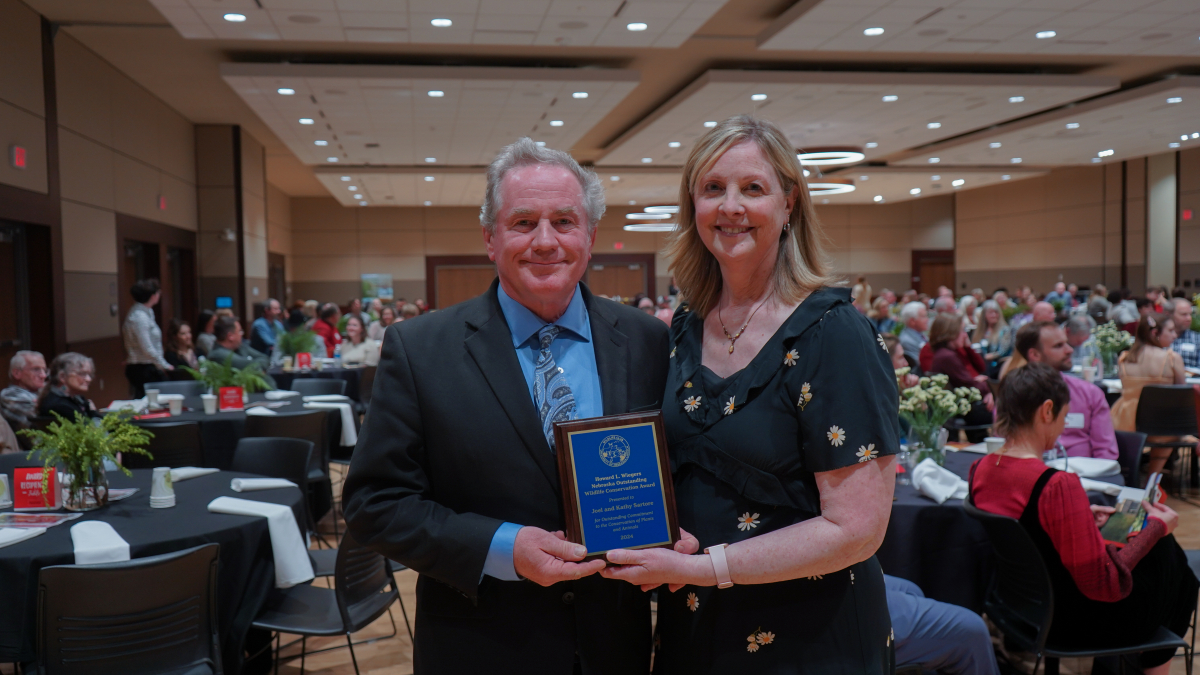
by Marissa Lindemann
Conservation is for everyone.
That was the message Joel Sartore shared in his acceptance speech on Saturday at the School of Natural Resources spring banquet after he and his wife, Kathy Sartore, won the Howard L. Wiegers Nebraska Outstanding Wildlife Conservation Award.
Named after the University of Nebraska-Lincoln’s Wildlife Club’s advisor in 1960 when the club hosted its first spring banquet, the Howard L. Wiegers Award honors those “who have devoted their lives to conservation of wildlife and have inspired many others through their work and accomplishments.”
Joel Sartore is well-known for his work as a photographer for National Geographic Magazine, as well as for creating the photo ark, a project in which he works to photograph every species in the world’s zoos, aquariums, and human-operated wildlife spaces. The award the Sartores received from SNR honors their effort to preserve habitat in the Nebraska Sandhills.
“I see a lot of sad things in the world because I travel around the world, and it's nice to be able to come back home and know that we're part of a beautiful place,” Joel Sartore said.
Since 2017, Kathy and Joel Sartore have been purchasing land in the Sandhills that functions as both pasture for cattle and a wetland habitat for thousands of birds. To date, they own 5,700 acres in Sheridan County, which serves as valuable habitat for long-billed curlews, yellow-headed blackbirds, and a variety of shorebirds, swans, ducks and geese that all thrive in the marshlands and lakes on the property.
Kathy said they were pleasantly surprised when they found out about the award. Although Joel had received numerous awards for his photography, this was her first time receiving an award.
“We just do it because we think it's the right thing and we like the land out there. It's so beautiful,” she said.
The Sartores said their inspiration for their Sandhills conservation work began with a visit to Crescent Lake National Wildlife Refuge. They were both drawn to the landscape, and after Kathy’s fight with breast cancer they experienced what Joel described as a “wake-up call”.
“We think that life is short, and we want to try to do good with our lives,” Joel Sartore said.
Joel began looking at listings for land in the Sandhills. One particular advertisement caught Joel’s attention. It described an alkaline wetland where over 100,000 “mud puppies” (the larval form of Eastern Tiger Salamanders) were harvested for catfish bait every year. The Eastern Tiger Salamander, once abundant throughout the state of Nebraska, has become increasingly rare and has sparked major concern among professors of natural resources, including Dennis Ferraro, a conservation biologist and herpetologist in the School of Natural Resources.
Joel remembers that he and Kathy agreed they needed to act to help protect not only the salamanders, but all the wildlife that live in the Nebraska Sandhills.
“I see that the world is getting completely devoured by humanity. And so this is our little attempt to try to make things right,” Joel Sartore said.
The Sartores emphasized that buying land isn’t the only way to practice conservation. If someone wants to do their part to protect the environment, Joel Sartore suggested choosing to use reusable bags at the grocery store, setting up a year-long bird feeder and avoiding pesticide use on lawns.
“You don't have to have money, and you don't have to travel to do big things for the environment,” he said. “You can do big things right in your own backyard.”
The award the Sartores received was one of several distributed at the School of Natural Resources spring banquet. Approximately 250 people were in attendance to celebrate the accomplishments of the clubs, students, staff, and faculty that make up the School of Natural Resources.
The couple would like to thank Dr. Ron Case, an emeritus professor in the School of Natural Resources, for nominating them for the award. Additionally, they would like to thank Michael Forsberg for teaching them about the sandhills and Dakota Altman for linking them to the Sandhills.
See the full list of award winners at https://snr.unl.edu/aboutus/what/awards/banquetawards2024.aspx